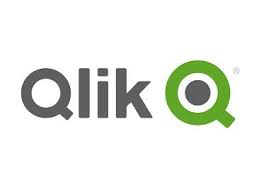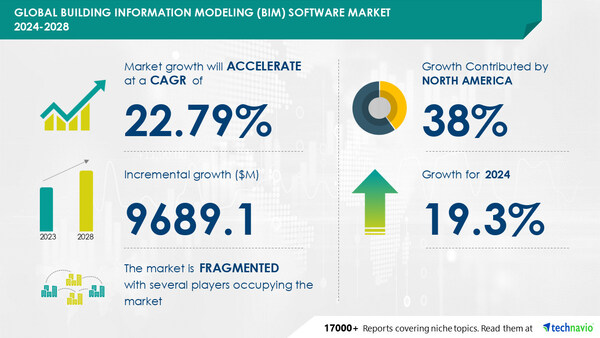Building Information Modeling Software Market size is set to grow by USD 9.68 Bn from 2024-2028
The global building information modeling (BIM) software
market size is estimated to grow by USD 9.68 billion from 2024-2028, according to
Technavio. The market is estimated to grow at a CAGR of 22.79% during the
forecast period. Increasing need for management of large-scale projects is
driving market growth, with a trend towards growth of 5d building information
modeling. However, high implementation and operating costs poses a
challenge. Key market players include Asite Solutions Ltd., Autodesk Inc.,
Bentley Systems Inc., Dalux Corp., Dassault Systemes SE, Glodon Co. Ltd.,
Hexagon AB, KUBUS B.V., MRI Software LLC, Nemetschek SE, Oracle Corp., Pinnacle
Infotech, Plannerly, Planon Shared Services BV, Procore Technologies Inc.,
Revizto SA, Schneider Electric SE, thinkproject Holding GmbH, Trimble Inc., and
Virtual Construction and Technology BIM One Inc..
The construction industry has seen a shift towards more advanced
building information modeling (BIM) solutions to enhance project efficiency and
accuracy. While 3D BIM provides a three-dimensional representation of building
designs, it lacks integration for time and cost factors. This gap led to the
emergence of 5D BIM, an evolution of 4D BIM, which considers five dimensions
including time, cost, and labor productivity. With 5D BIM, investors can easily
access crucial information such as deviations from the pre-determined project
schedule and budget, an in-house database with complete cost and labor
productivity details, efficient preparation of cost schedules, and real-time
cost estimation for quick comparisons with the target cost. The development of 5D
BIM solutions is expected to significantly contribute to the growth of the
global BIM software market during the forecast period.
Key Trend
The BIM software market is thriving as construction companies embrace
digital technology for more efficient operations. BIM technology offers digital
representations of buildings, enabling cost estimation tools for budgeting and
cost control during the project life cycle. Contractors benefit from
construction schedules and sequencing plans, while architects and engineers use
BIM software for planning & modeling. Government mandates drive market
growth, with many mandating BIM usage in the construction sector. Initial
expenditure on BIM software can be high, but long-term benefits include virtual
reality (VR) and augmented reality (AR) for project visualization, IoT sensors
for facility management, and maintenance. BIM solutions come in on-premise and
cloud-based deployment modes, catering to various building types - commercial
and residential. The market includes components for construction & design,
asset management, and project visualization, streamlining decision-making
processes. Product launches continue, with innovations in cost control,
contractor collaboration, and real-time data access. Despite the benefits, low
productivity due to initial expenditure and learning curve hinder widespread
adoption. However, the trend towards digital construction is undeniable, with
BIM technology set to revolutionize the construction sector.
Market Challenges
- The global BIM (Building Information Modeling) software market growth is hindered by the high cost of these solutions. Small architectural and engineering firms in the construction industry find it challenging to adopt BIM software due to its expensive price tag. These software packages come with numerous modules for various applications, but they offer minimal value for SMEs with smaller project sizes. The high cost of training and support, as well as ongoing maintenance fees, further impedes market expansion. Additionally, the ongoing geopolitical conflict between Russia and Ukraine has disrupted the supply chain for construction materials, leading to increased implementation and operating costs. These rising costs may deter potential adopters of BIM software, thereby hindering market growth during the forecast period.
- The Building Information Modeling (BIM) market
is growing rapidly, driven by the need for efficient construction
operations and digital transformation in the industry. However, challenges
persist, such as the integration of AR and VR technologies like Bentley
Systems Incorporated's iTwin platform for project visualization.
Deployment modes, including on-premise and cloud-based solutions, impact
the commercial viability of BIM software for various building types, from
commercial to residential. BIM software solutions facilitate planning
& modeling, construction & design, asset management, and facility
management. Challenges include initial expenditure, low productivity, and
process changes. Training and education are essential for successful BIM
implementation. Government mandates and IoT sensors play a role in driving
BIM adoption. Bentley's engineering applications, such as structural
engineering and steel fabrication management, address specific challenges.
Product launch and decision-making processes are streamlined through BIM
technology, enhancing project life cycle efficiency. BIM software and
hardware require careful data management, especially during the
construction phase. Contractors and architects/engineers benefit from
BIM's ability to improve collaboration and coordination. Project
visualization and maintenance are essential components of BIM solutions.
The construction sector continues to evolve, with digital construction and
IoT sensors shaping the future of the industry. Bentley's infrastructure
cloud offers a comprehensive solution for managing BIM data and
facilitating efficient construction operations.






























Leave A Comment